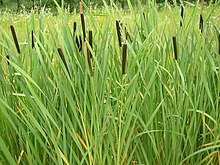Cattail
| Cattail | |
|---|---|
 |
|
| Typha latifolia | |
| Scientific classification | |
| Kingdom: | Plantae |
| (unranked): | Angiosperms |
| (unranked): | Monocots |
| (unranked): | Commelinids |
| Order: | Poales |
| Family: | Typhaceae |
| Genus: |
Typha L. |
| Synonyms | |
|
|
| Nutritional value per 100 g (3.5 oz) | |
|---|---|
| Energy | 106 kJ (25 kcal) |
|
5.14 g
|
|
| Sugars | 0.22 g |
| Dietary fiber | 4.5 g |
|
0.00 g
|
|
|
1.18 g
|
|
| Vitamins | |
| Vitamin A equiv. |
(0%)
1 μg
(0%)
6 μg |
| Thiamine (B1) |
(2%)
0.023 mg |
| Riboflavin (B2) |
(2%)
0.025 mg |
| Niacin (B3) |
(3%)
0.440 mg |
| Pantothenic acid (B5) |
(5%)
0.234 mg |
| Vitamin B6 |
(9%)
0.123 mg |
| Folate (B9) |
(1%)
3 μg |
| Choline |
(5%)
23.7 mg |
| Vitamin C |
(1%)
0.7 mg |
| Vitamin K |
(22%)
22.8 μg |
| Minerals | |
| Calcium |
(5%)
54 mg |
| Iron |
(7%)
0.91 mg |
| Magnesium |
(18%)
63 mg |
| Manganese |
(36%)
0.760 mg |
| Phosphorus |
(6%)
45 mg |
| Potassium |
(7%)
309 mg |
| Sodium |
(7%)
109 mg |
| Zinc |
(3%)
0.24 mg |
| Other constituents | |
| Water | 92.65 g |
|
|
| Percentages are roughly approximated using US recommendations for adults. Source: USDA Nutrient Database |
|
Typha /ˈtaɪfə/ is a genus of about 30 species of monocotyledonous flowering plants in the family Typhaceae.
The genus is largely distributed in the Northern Hemisphere, where it is found in a variety of wetland habitats.
These plants have many common names. They may be known in British English as bulrush, or reedmace, in American English as cattail,punks, or corn dog grass, in Australia as cumbungi or bulrush, in Canada as bulrush or cattail, and in New Zealand as raupō. Other taxa of plants may be known as bulrush, including some sedges in Scirpus and related genera.
The rhizomes are edible. Evidence of preserved starch grains on grinding stones suggests they were already eaten in Europe 30,000 years ago.
Typha leaves are alternate and mostly basal on a simple, jointless stem that bears the flowering spikes. The plants are monoecious, with unisexual flowers that develop in dense racemes. The numerous male flowers form a narrow spike at the top of the vertical stem. Each male (staminate) flower is reduced to a pair of stamens and hairs, and withers once the pollen is shed. Large numbers of tiny female flowers form a dense, sausage-shaped spike on the stem below the male spike. In larger species this can be up to 30 centimetres (12 in) long and 1 to 4 centimetres (0.4 to 2 in) thick. The seeds are minute, 0.2 millimetres (0.008 in) long, and attached to fine hairs. When ripe, the heads disintegrate into a cottony fluff from which the seeds disperse by wind.
...
Wikipedia
